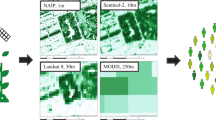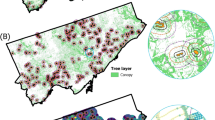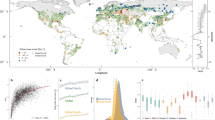Abstract
The health benefits of exposure to trees and plants is a rapidly expanding field of study. Research has shown that exposure is associated with improvements in a wide range of health outcomes including cardiovascular disease, birth outcomes, respiratory disease, cancer, mental health and all-cause mortality1. One of the challenges that these studies face is characterizing participants’ exposure to trees and plants. A common approach is to use the normalized difference vegetation index, a greenness index typically derived from satellite imagery. Reliance on the normalized difference vegetation index is understandable; for decades, the imagery required to calculate the normalized difference vegetation index has been available for the entire Earth’s surface and is updated at regular intervals. However, the normalized difference vegetation index may do a poor job of fully characterizing the human experience of being exposed to trees and plants, because scenes with the same normalized difference vegetation index value can appear different to the human eye. We demonstrate this phenomenon by identifying sites in Portland, Oregon that have the same normalized difference vegetation index value as a large, culturally significant elm tree. These sites are strikingly different aesthetically, suggesting that use of the normalized difference vegetation index may lead to exposure misclassification. Where possible, the normalized difference vegetation index should be supplemented with other exposure metrics.
This is a preview of subscription content, access via your institution
Access options
Access Nature and 54 other Nature Portfolio journals
Get Nature+, our best-value online-access subscription
$29.99 / 30 days
cancel any time
Subscribe to this journal
Receive 12 digital issues and online access to articles
$119.00 per year
only $9.92 per issue
Buy this article
- Purchase on Springer Link
- Instant access to full article PDF
Prices may be subject to local taxes which are calculated during checkout




Similar content being viewed by others
Data availability
High-density Oregon Department of Geology and Mineral Industries (DOGAMI) LiDAR data were obtained from ftp://lidar.engr.oregonstate.edu/OREGON LIDAR CONSORTIUM PROJECT DATA/OLC METRO 2014/ Landsat 8 data were obtained from Google Earth Engine36. The 3-m multispectral, satellite imagery was obtained from Planet37.
References
Twohig-Bennett, C. & Jones, A. The health benefits of the great outdoors: a systematic review and meta-analysis of greenspace exposure and health outcomes. Environ. Res. 166, 628–637 (2018).
Woodcock, C. E. et al. Free access to Landsat imagery. Science 320, 1011 (2008).
Tigges, J., Lakes, T. & Hostert, P. Urban vegetation classification: benefits of multitemporal RapidEye satellite data. Remote Sens. Environ. 136, 66–75 (2013).
Chaix, B. et al. GPS tracking in neighborhood and health studies: a step forward for environmental exposure assessment, a step backward for causal inference? Health Place 21, 46–51 (2013).
Passchier-Vermeer, W. & Passchier, W. F. Noise exposure and public health. Environ. Health Perspect. 108, 123–131 (2000).
Weilnhammer, V. et al. Extreme weather events in Europe and their health consequences–a systematic review. Int. J. Hyg. Environ. Health 233, 113688 (2021).
Donovan, G. H., Gatziolis, D., Jakstis, K. & Comess, S. The natural environment and birth outcomes: comparting 3D exposure metrics derived from LiDAR to 2D metrics based on the Normalized Difference Vegetation Index. Health Place 57, 305–312 (2019).
Gascon, M. et al. Normalized Difference Vegetation Index (NDVI) as a marker of surrounding greenness in epidemiological studies: the case of Barcelona city. Urban For. Urban Green. 19, 88–94 (2016).
Reid, C. E., Kubzansky, L. D., Li, J., Shmool, J. L. & Clougherty, J. E. It’s not easy assessing greenness: a comparison of NDVI datasets and neighborhood types and their associations with self-rated health in New York City. Health Place 54, 92–101 (2018).
Donovan, G. H., Gatziolis, D., Longley, I. & Douwes, J. Vegetation diversity protects against childhood asthma: results from a large New Zealand birth cohort. Nat. Plants 4, 358–364 (2018).
Hystad, P. et al. Residential greenness and birth outcomes: evaluating the influence of spatially correlated built-environment factors. Environ. Health Perspect. 122, 1095–1102 (2014).
Triguero-Mas, M. et al. Natural outdoor environments and mental and physical health: relationships and mechanisms. Environ. Int. 77, 35–41 (2015).
Nowak, D. J., Crane, D. E. & Stevens, J. C. Air pollution removal by urban trees and shrubs in the United States. Urban For. Urban Green. 4, 155–123 (2006).
James, P., Banay, R. F., Hart, J. E. & Laden, F. A review of the health benefits of greenness. Curr. Epidemiol. Rep. 2, 131–142 (2015).
Li, D. & Sullivan, W. C. Impact of views to school landscapes on recovery from stress and mental fatigue. Landsc. Urban Plan. 148, 149–158 (2016).
Velarde, M., Fry, G. & Tveit, M. Health effects of viewing landscapes – landscape types in environmental psychology. Urban For. Urban Green. 6, 199–212 (2007).
Ulrich, R. S. Visual landscapes and psychological well‐being. Landsc. Res. 4, 17–23 (1979).
Ulrich, R. S. View through a window may influence recovery from surgery. Science 224, 420–421 (1984).
Kaplan, S. The restorative benefits of nature: toward an integrative framework. J. Environ. Psychol. 15, 169–182 (1995).
De Vries, S., Van Dillen, S. M., Groenewegen, P. P. & Spreeuwenberg, P. Streetscape greenery and health: stress, social cohesion and physical activity as mediators. Soc. Sci. Med. 94, 26–33 (2013).
Sugiyama, T., Leslie, E., Giles-Corti, B. & Owen, N. Associations of neighbourhood greenness with physical and mental health: do walking, social coherence and local social interaction explain the relationships? J. Epidemiol. Community Health 62, e9 (2008).
Saelens, B. E., Sallis, J. F., Black, J. B. & Chen, D. Neighborhood-based differences in physical activity: an environment scale evaluation. Am. J. Public Health 93, 1552–1558 (2003).
Ball, K., Bauman, A., Leslie, E. & Owen, N. Perceived environmental aesthetics and convenience and company are associated with walking for exercise among Australian adults. Prev. Med 33, 434–440 (2001).
Coombes, E., Jones, A. P. & Hillsdon, M. The relationship of physical activity and overweight to objectively measured green space accessibility and use. Soc. Sci. Med. 70, 816–822 (2010).
Fan, Y., Das, K. V. & Chen, Q. Neighborhood green, social support, physical activity, and stress: assessing the cumulative impact. Health Place 17, 1202–1211 (2011).
Ribe, R. G. The aesthetics of forestry: what has empirical preference research taught us? Environ. Manag. 13, 55–74 (1989).
Liddicoat, C. et al. Naturally-diverse airborne environmental microbial exposures modulate the gut microbiome and may provide anxiolytic benefits in mice. Sci. Total Environ. 701, 134684 (2020).
Haahtela, T. et al. The biodiversity hypothesis and allergic disease: World Allergy Organization position statement. World Allergy Organ. J. 6, 3 (2013).
Mohammed, G. H. et al. Natural and Stress-induced Effects on Leaf Spectral Reflectance in Ontario Species (Ontario Ministry of Natural Resources, 2000).
Barron, S. et al. What do they like about trees? Adding local voices to urban forest design and planning. Trees Forests People 5, 100116 (2021).
Lohr, V. I. & Pearson-Mims, C. H. Responses to scenes with spreading, rounded, and conical tree forms. Environ. Behav. 38, 667–688 (2006).
Portland Parks and Recreation. Heritage Trees of Portland https://www.portlandoregon.gov/parks/40280 (2020).
Rojas-Rueda, D., Nieuwenhuijsen, M. J., Gascon, M., Perez-Leon, D. & Mudu, P. Green spaces and mortality: a systematic review and meta-analysis of cohort studies. Lancet Planet. Health 3, e469–e477 (2019).
Strunk, J. L. et al. Evaluation of pushbroom DAP relative to frame camera DAP and lidar for forest modeling. Remote Sens. Environ. 237, 111535 (2020).
Jiang, B. et al. Remotely-sensed imagery vs. eye-level photography: evaluating associations among measurements of tree cover density. Landsc. Urban Plan. 157, 270–281 (2017).
Gorelick, N. et al. Google Earth Engine: planetary-scale geospatial analysis for everyone. Remote Sens. Environ. 202, 18–27 (2017).
Planet Team. Planet Application Program Interface: In Space for Life on Earth (Planet, 2022); https://api.planet.com
Acknowledgements
This work utilized data made available through the NASA Commercial Smallsat Data Acquisition (CSDA) Program.
Author information
Authors and Affiliations
Contributions
G.H.D., D.G., M.D. and J.D. developed the original idea. G.H.D. and D.G. conducted the analysis. G.H.D., D.G., M.D., Y.L.M., J.P.D. and J.D. wrote and edited the paper.
Corresponding author
Ethics declarations
Competing interests
The authors declare no competing interests.
Peer review
Peer review information
Nature Plants thanks Peter James and the other, anonymous, reviewer(s) for their contribution to the peer review of this work.
Additional information
Publisher’s note Springer Nature remains neutral with regard to jurisdictional claims in published maps and institutional affiliations.
Supplementary information
Supplementary Information
Supplementary Figs. 1 and 2.
Rights and permissions
About this article
Cite this article
Donovan, G.H., Gatziolis, D., Derrien, M. et al. Shortcomings of the normalized difference vegetation index as an exposure metric. Nat. Plants 8, 617–622 (2022). https://doi.org/10.1038/s41477-022-01170-6
Received:
Accepted:
Published:
Issue Date:
DOI: https://doi.org/10.1038/s41477-022-01170-6
This article is cited by
-
Surrounding greenness is associated with lower risk and burden of low birth weight in Iran
Nature Communications (2023)
-
The association between greenery type and gut microbiome in schizophrenia: did all greenspaces play the equivalent role?
Environmental Science and Pollution Research (2023)



